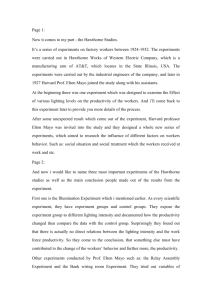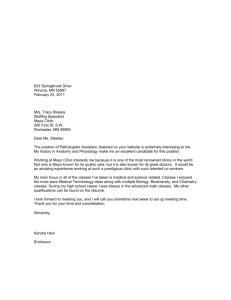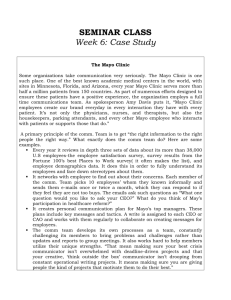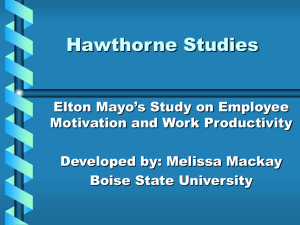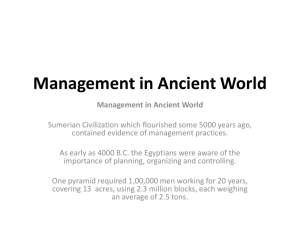Mayo`s Experiment - Business Studies A Level for WJEC
advertisement
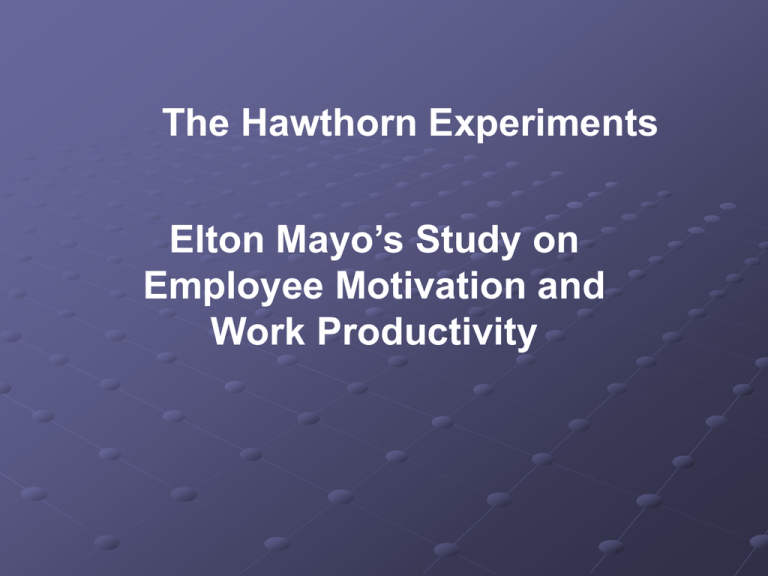
The Hawthorn Experiments Elton Mayo’s Study on Employee Motivation and Work Productivity The Hawthorne Studies were conducted from 19271932 at the Western Electric Hawthorne Works in Chicago, where Harvard Business School Professor Elton Mayo examined productivity and work conditions. Mayo wanted to find out what effect fatigue and monotony had on job productivity and how to control them through such variables as rest breaks, work hours, temperatures and humidity – but he discovered something more important, the working of ‘group dynamics’. Mayo’s Experiment • Five women assembled telephone relays, one supplied the parts. • Mayo made frequent changes in working conditions with the workers consent. • Records were kept of relays made, temperature and humidity of rooms, medical and personal histories. • No one supervised the female employees. • They were told to work any way that felt best and at a comfortable pace. • Productive capacity was measured by recording the employees output for two weeks before the study began. • First five weeks, no changes were made. • Third stage, a pay system was ensured allowing the workers to earn in proportion to their efforts. • Eight weeks later, two five-minute rest pauses were added. • Eighth phase, workday ended a half-day early. • Ninth phase, the girls finished an hour earlier than usual. • Five-day week introduced. • Girls went back to no breaks, lunches and a full work week, output declined for those twelve weeks. Results Output went up when: •They were put on piece-work for eight weeks. •Two five minute rest pauses were introduced for five weeks. •Rest pauses were lengthened to ten minutes. •A hot meal was supplied during first break •They were dismissed at 4:30 p.m. instead of 5:00 p.m •Output slightly fell when six five minute pauses were added. •It remained the same when they were dismissed at 4:00 p.m. instead of 4:30 p.m The experiment was then reproduced using male workers. The responses were quite different from, and often the reverse of those found when investigating female workers. The factors that increased output with the female workers, often saw no change or even a decrease in output, under male workers. The conclusions from Mayo’s experiments may seem obvious now, but the factory had been operating under Taylorian conditions. Conclusions. • Work is a group activity – group dynamics can dictate reactions to change • Attitudes and effectiveness are conditioned by social demands – workers are influenced by other workers. • Informal groups at work are strong social controls over the work habits and attitudes of a worker •Need for recognition, security and sense of belonging Management need to : • Gain active support and participation from workers, while maintaining managerial control. • Be patient with workers, listen to them, and avoid creating emotional upsets. • Transfer of power to workers will only work if management knows their workers and how group dynamics work. • Encourage positive groups, discourage negative groups Management need to : • Encourage insights, and suggestions from workers • Encourage co-operation, communication, sense of belonging. • Provide incentives to increase productivity and quality Mayo on group dynamics “Man’s desire to be continuously associated in work – with his fellows is a strong, if not the strongest, human characteristic. Any disregard of it by management or any ill-advised attempt to defeat this human impulse leads instantly to some form of defeat for management itself.”


